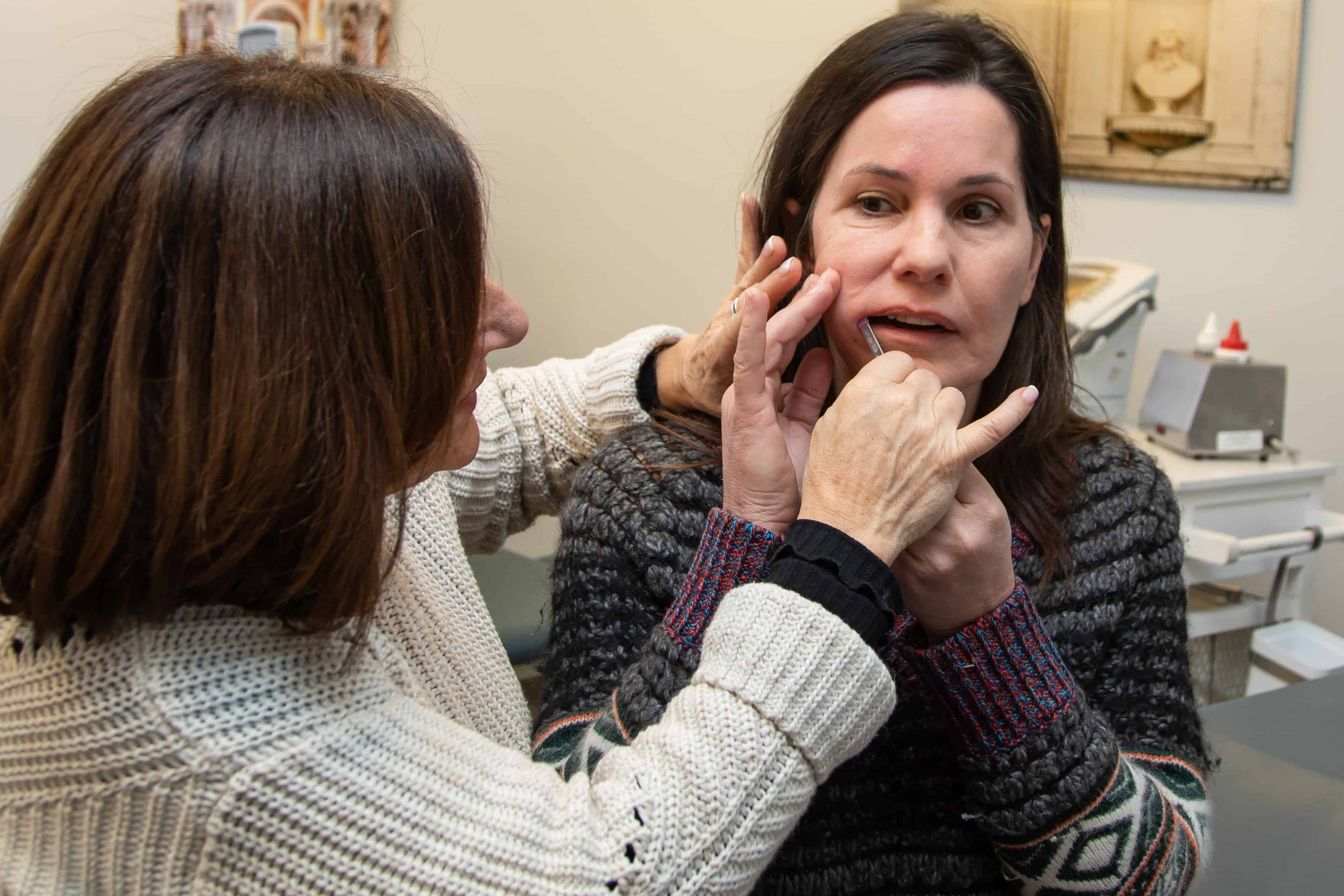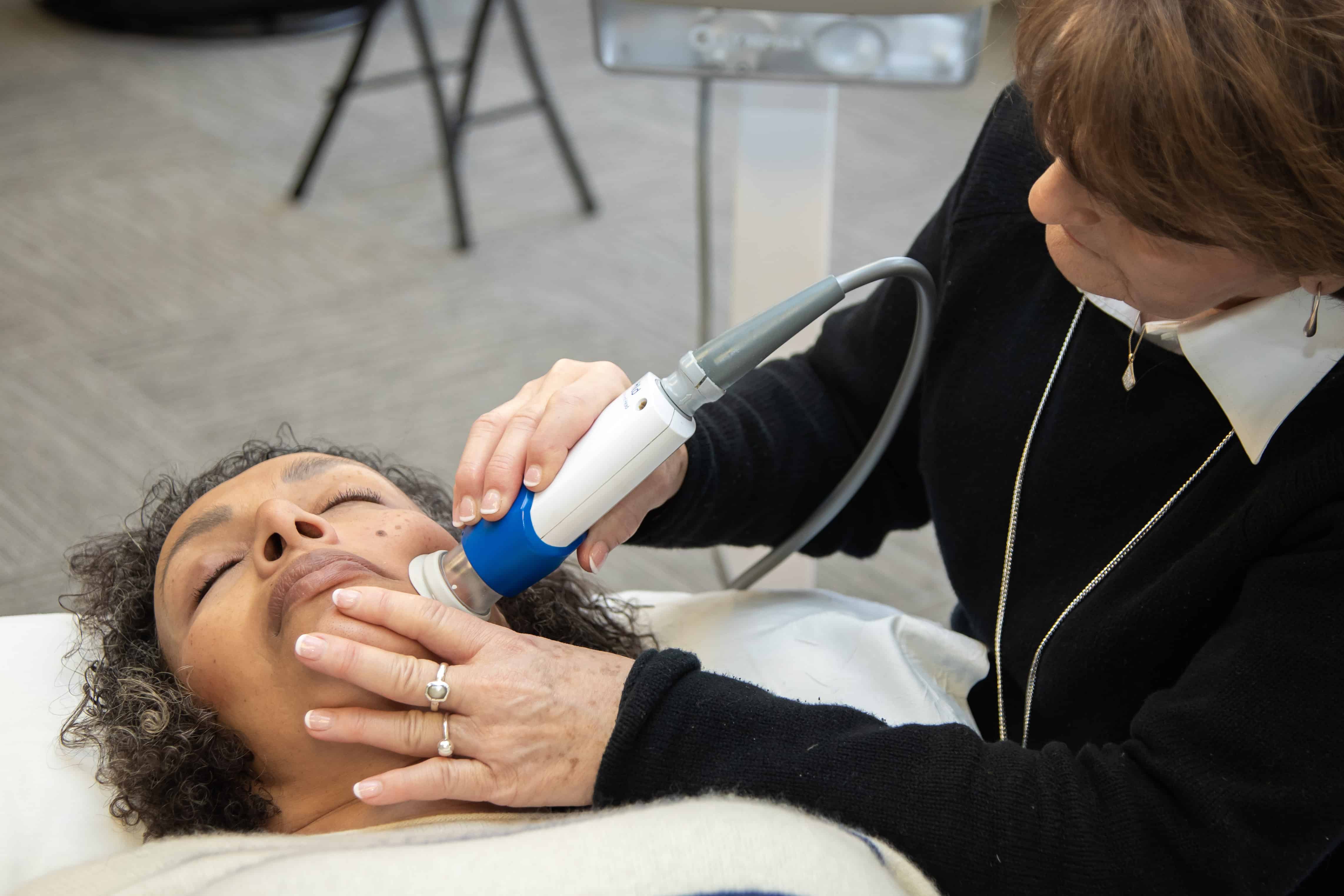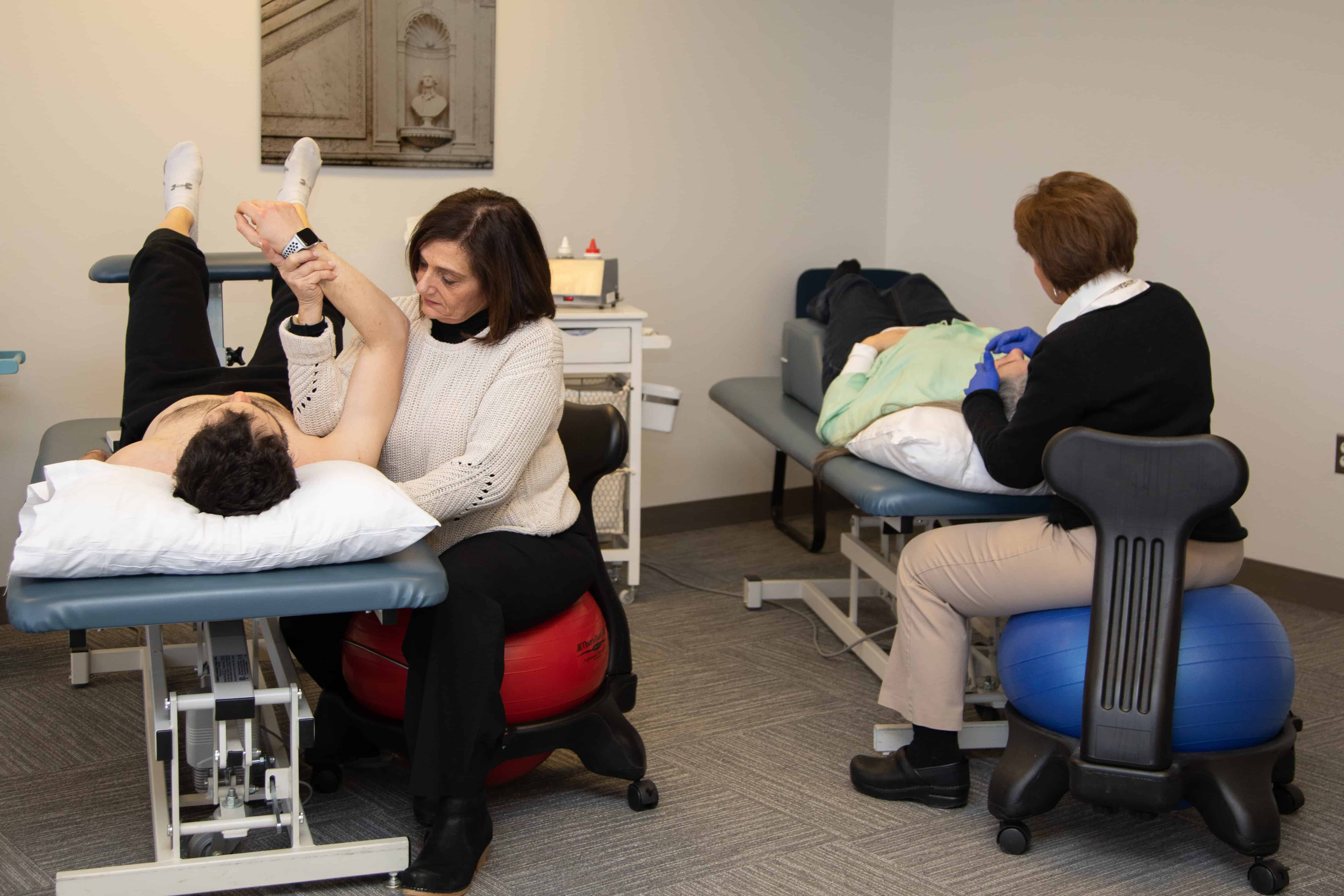


Customized, coordinated services and treatments to help you feel better.
At The Center for Facial Recovery, we provide our patients with comprehensive, customized, head-to-toe evaluations and treatment plans. We bring 40 years of experience and a large toolbox of therapies aimed at helping our patients regain function. Based on our findings, we’ll partner with you and all of your health care providers to design a unique and individualized treatment plan. If you don’t yet have a comprehensive medical team, we’ll coordinate your care with our team of affiliated experts in the fields of facial palsy, TMD treatment, and postural wellness. Our services and treatments include:
The Mirror Book and Mirror Book mobile app – groundbreaking rehabilitation devices invented by the Center’s founders – provide real-time, twice-reflected visual feedback of the unaffected side of the face to encourage facial palsy patients to begin therapy immediately while reducing the psychological impact of looking in the mirror.
Temporomandibular disorder (TMD) is a condition characterized by pain in the jaw joint and/or surrounding tissues. Because there are a variety of symptoms and causes linked to this diagnosis, identifying these disorders can be difficult and inexact. The Center’s therapists have undergone extensive training in this field and use their expertise to determine how best to manage your symptoms in collaboration with your dental and other health care providers. Treatments incorporated into your care may include: postural evaluation and education; manual therapy to improve joint and muscle mobility; therapeutic exercises to strengthen the muscles of the jaw and neck region; pain management, utilizing modalities such as ultrasound; dry needling techniques to decrease trigger points, muscle spasm, and pain; biofeedback for stress management and relaxation techniques; and graded motor imagery to assist with chronic pain symptoms.
Neuromuscular re-education is a therapeutic technique that retrains the brain and addresses conditions arising from faulty nerve and muscle activities. These interventions may help improve a variety of conditions associated with postural problems and aches and pains, including back and neck pain, flexibility, joint mobility, repetitive strain injuries, poor circulation, and emotional stress.
Neuromuscular re-education aims to restore natural and energy-efficient movement patterns, optimize joint biomechanics, and reduce pain that may result from neuromuscular deficiencies. Injuries, repetitive use, poor posture, and unhealthy biomechanics can hinder movement patterns. Exercises are beneficial for unhealthy movement patterns that persist after injuries and can help clients improve balance, coordination, and posture; the broad goal being to restore normal movement by coordinating mental perception with physical behavior.
Cranial-sacral therapy is a gentle, non-invasive, hands-on healing modality that focuses on the wave-like rhythmic pulse that goes through the entire body. This therapy emphasizes the role of the musculoskeletal system in health and disease. During cranial-sacral therapy, the therapist makes light contact at selected points around the head, torso, knees, and feet. This light contact consists of gentle finger pressure, with no bone manipulation or forceful movements.
The practitioner notes what he or she perceives at selected points on the body and in the craniosacral system with the goal of helping to decrease central nervous system restrictions and improve functioning. Craniosacral therapy can be used to treat headaches, chronic pain, chronic fatigue syndrome, post-traumatic stress disorder and other traumas, post-surgical recovery, and TMD, among other ailments.
Advanced therapeutic exercises are targeted exercises meant to correct specific problems. Depending on the matter of your concern, we’ll teach you exercises to perform in order to reduce discomfort and acquire a maximum level of fitness and self-management of symptoms. The focus of therapeutic exercise is to regain flexibility, strength, and endurance related to specific physical problems. Therapeutic exercise aims to improve, restore, and prevent loss of physical function. It also improves our patients’ overall health, fitness, and sense of well-being. Additional objectives include: increasing mobility; releasing contracted muscles, tendons, and fascia; mobilizing joints; improving circulation; improving respiratory capacity; improving coordination; reducing rigidity, and improving balance. We emphasize therapeutic exercises to be performed at home to improve our clients’ quality of life.
Biofeedback techniques often allow our patients to improve health conditions by learning how to manage anxiety, stress, asthma, ADHD, chemotherapy side effects, chronic pain, fibromyalgia, headaches, high blood pressure, Irritable Bowel Syndrome, Raynaud’s disease, tinnitus, stroke, and TMD, among others. During biofeedback, clients are connected to electrical sensors that produce information about their bodies. This feedback helps patients make subtle changes in their bodies – such as relaxing certain muscles to achieve pain relief. Our therapists use a variety of biofeedback methods, depending on your health issues and goals. Unique to our clinic, we are pleased to offer ultrasound imaging to provide biofeedback for muscle redirection in conditions such as facial weakness and muscle imbalance.
Other types of biofeedback monitoring include: brain waves, breathing, heart rate, muscle contraction, sweat gland activity, and temperature. Additionally, biofeedback is noninvasive; may reduce or eliminate the need for medications or potentially enhance the benefits of medications. It’s also helpful for pregnant women who cannot take certain medications during pregnancy.
Use of this particular soft tissue imaging technique provides real-time data, which allows us to visualize the muscles and different structures with functional movement compared to traditional static imaging modalities (such as x-rays and MRIs). Seeing the whole segment move during the examination allows us to see how interdependent structures interact, allowing a greater understanding of structural and/or functional deficits.
We utilize diagnostic ultrasound as an alternative to EMGs/ENGs for patients with facial palsy. We are currently conducting an ongoing study to confirm that the use of ultrasound techniques to assess early synkinetic activity in patients with facial palsy allows for better recovery outcomes.
Manual physical therapy is a specialized form of hands-on health care. Our expert therapists have been trained in a variety of manual therapy techniques, including moving the joints in specific directions to regain movement (joint mobilizations), muscle stretching, passive movements, and movements designed to improve muscle activation. Specific soft tissue techniques are also used to improve the mobility and functioning of fascial tissue, nerves, and muscles. Our one-on-one sessions allows for optimal results.
In addition, the natural healing effects of human touch is an essential aspect of our treatment philosophy. Most patients experience a faster recovery and improved sense of well-being when manual therapy is used in conjunction with exercise and education.
Our therapists hold certifications from the State of Maryland in this safe and effective procedure which is used for the management of neuromuscular pain and tension. A thin monofilament needle is used to penetrate the skin to help release fibrous bands or trigger points and fascial thickness which restricts free movement of the muscles and tissues under the skin. This technique is used in conjunction with other physical therapy interventions for greater success
At our practice, we are firm believers in the benefits of therapeutic taping. These techniques address a multitude of head-to-toe symptoms and dysfunctions.
Synkinesis is one of the most devastating effects of facial paralysis. It is defined as abnormal, involuntary facial movement that occurs with voluntary movement of other facial muscles. For example, when a person puckers or smiles, his or her eye closes. Synkinesis can cause functional limitations that impact activities such as eating, drinking, smiling, and articulation. Our patients often come to us misinformed about how to manage their symptoms. Sometimes we find that they have been doing exercises or electrical stimulation that can actually make their condition worse. At the Center, we educate our patients on what they should and should not do, as well as provide therapy and home exercise programs to help resolve synkinesis-related problems.
These techniques are safe and effective ways to mobilize fascia in order to relieve muscle spasms, release restricted tissue, and increase blood flow. They stretch stubborn areas almost anywhere in the body in a much more comfortable manner, fostering relaxation and well-being. As additional tools that we utilize to provide pain relief and improve mobility, these interventions have many benefits for a multitude of symptoms and diagnoses.
RPT is a highly-effective breakthrough therapy that is used throughout the body to penetrate radial pulse waves into chronically injured areas. This process disperses scar tissue and creates revascularization (new blood supply) to facilitate natural healing. People with chronic muscle, tendon, and connective tissue pain often have old patterns that have developed. RPT uses a hand instrument to generate a pulsing, mechanical pressure wave that travels deep down into the surrounding tissue, spreading as it penetrates. RPT is especially effective when combined with our other soft tissue therapies. It is also fast and convenient and can reduce the need for surgery. RPT is indicated to treat pain from muscle, tendon, ligament, and bone injuries due to trauma, overuse, or arthritis. Pain relief and improved range of motion are usually noticed immediately following a session.
Unique to our practice, we use RPT for treatment of TMD and facial palsy. Our clinical studies have shown – based on ultrasound images – that this technique improves mobility of tissue and allows for improved muscle activity
Neurotoxin, i.e.Botox, for synkinesis can be used to improve facial symmetry by reducing the activity of certain facial muscles. We confer closely with several of our affiliated physicians, or we can work with your preferred physician, to provide guidance regarding areas that would best benefit from this intervention. Neurotoxin for synkinesis may be used in combination with selective neurolysis and/or facial neuromuscular therapy. It reduces muscle activity, minimizing the synkinetic effects associated with overactive and uncoordinated muscles. The most common injection areas to treat synkinesis are eye muscles, neck bands, chin, and forehead.
Synkineedling is a technique pioneered by Center co-founder Jodi Barth, PT. The treatment goal is to stop or decrease synkinesis – unwanted movements that occur with volitional and spontaneous movements (for example, your eye closes when you smile). The treatment also aims to restore proper function to these abnormally behaving muscles that have become locked into dysfunction. For this treatment, we use filament needles to break up minor lesions in the soft tissue to activate healing.
After working extensively with Dr. Victor Ibrahim to perform ultrasound diagnostics on our patients, we noted fibrotic tissue surrounding the muscles that were impacted by the synkinesis. We began to utilize Synkineedling to shut down the overactive muscles, as well as to isolate and activate the weaker muscles. We also incorporate neuromuscular re-education during the process. Our practice’s internal studies have shown that our techniques and unique interventions reduce the severity of this abnormal activity by at least fifty percent.
The team at Center for Facial Recovery prides itself on our personal touch, and we are not limited by the walls of our clinic. We have designed innovative techniques to allow us to assist and guide our patients through their recovery. Our Telehealth program educates and empowers our patients to follow their treatment plans without having to travel to our office. We leverage technology to connect with each patient and provide an individualized exercise plan and recommendations to help them stay on the course to recovery.
Laser therapy accelerates the body’s own natural healing process through photo-bio-stimulation. Laser therapy can be used to treat acute, subacute, and chronic phases of non-surgical or post-surgical conditions. Using the different lasers that we have available, we are able to target both superficial and deeper structures.
Learning how to be posturally aware has many benefits in accomplishing an optimal state of health. Proper posture means maintaining a neutral spine. Some major benefits of good posture include increased energy flow through the body; improved oxygenation; reduction of pressures on the intervertebral discs; and avoidance of myofascial trigger points which can occur due to development of muscle imbalances as a result of poor posture. Correcting poor posture is a process that occurs gradually. Postural awareness training is an emphasis for all patients at the Center regardless of their diagnosis.